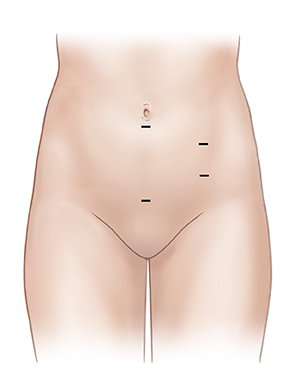Laparoscopic Retropubic Suspension
Laparoscopic Retropubic Suspension
To help treat stress urinary incontinence (SUI), your surgeon may do a procedure called retropubic suspension. This surgery is done laparoscopically through small incisions in the belly. During the surgery, sutures are used to firmly support the pelvic organs and help prevent urine leakage. Your surgery will take about 2 hour(s). You will be asked to do some things at home to prepare for surgery. Below are guidelines to help you get ready. If you have any questions, call your nurse or doctor.
About 2–4 small incisions are made in the belly. |
|
How should I prepare for the surgery?
The weeks before surgery
Tell your doctor about aspirin and other medicines, vitamins, or herbs you take. Ask if you should stop taking them before surgery.
Stop smoking to help reduce your risks during surgery.
If you have been given any prescriptions to fill, do this before surgery.
The night before surgery
You may be asked to give yourself an enema. This cleans out your bowels for surgery. You’ll be told how to do it.
Do not eat, drink, or chew anything after the midnight before surgery, as instructed. This includes water and chewing gum. But if you’ve been told to take any medicines, swallow them with small sips of water.
The day of surgery
Arrive at the hospital a few hours before surgery as directed. Have someone drive you there who can also stay during the surgery, and drive you home. At the hospital, your temperature and blood pressure will be taken. In some cases, tests may be done. Then, you will receive one or more IV (intravenous) lines. These lines give you fluids and medicines before, during, and after surgery. Some of your pubic hair may be removed. Tight stockings may be put on your legs to help prevent blood clots.
About anesthesia
To keep you pain-free during surgery, you’ll receive anesthesia. General anesthesia allows you to sleep. Regional anesthesia numbs the lower part of your body. Local anesthesia numbs the area that will be operated on. Before surgery, you’ll meet with the anesthesiologist or nurse anesthetist. He or she can tell you what kind of anesthesia you will receive and answer questions you may have.
What happens during the procedure?
Small incisions are made in the belly.
A laparoscope (a thin, telescope-like tool) is put into the belly through one of the incisions. This lets the surgeon look inside your body.
The surgeon does the surgery through the other small incisions. Sutures (stitches) are put through the tissue next to the vagina to help support the urethra and bladder firmly in place. This helps keep the urethra closed to prevent urine leakage.
The incisions are closed with sutures, staples, or surgical tape.
What are the risks and complications?
The risks and complications of this procedure may include:
Infection
Bleeding
Risks of anesthesia
Blood clots
Damage to nerves, muscles, bladder, or nearby pelvic structures
Trouble urinating
Urinary urgency
Mesh complications
Updated:
June 20, 2018
Reviewed By:
Brown, Kim, APRN,Greenstein, Marc, DO,Image reviewed by StayWell medical illustration team.

